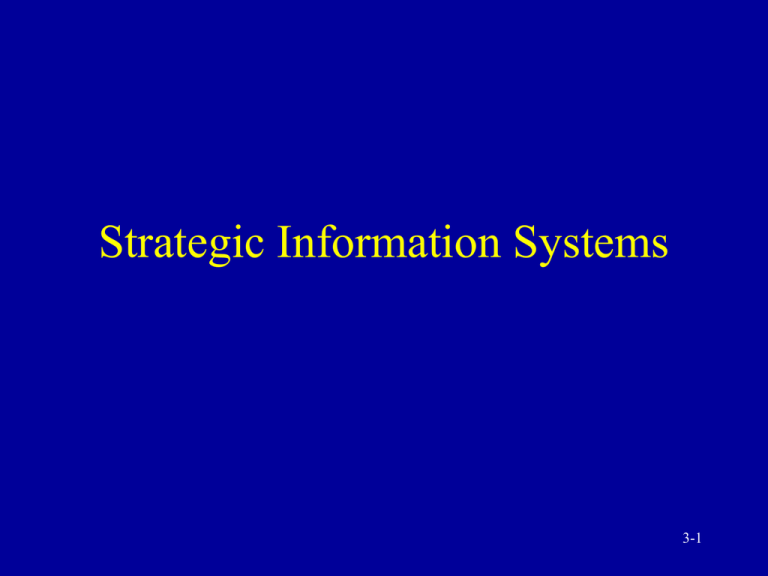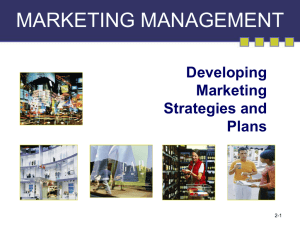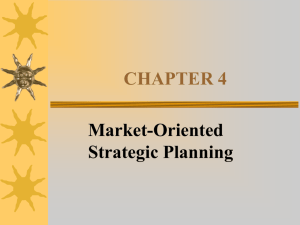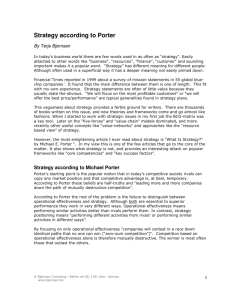
Strategic Information Systems
3-1
Strategic Advantage and IT
• Strategic Information System (SIS)
• Elements of strategic management
3-2
Elements of Strategic
Management
• Innovation
• Role of IT
• Competitive intelligence
3-3
Competitive Intelligence
• Internet
• Competitive strategy and sustainable
advantage
3-4
Porter’s Competitive Forces
Model
•
•
•
•
•
Threat of new competitors
Bargaining power of suppliers
Bargaining power of customers
Threat of substitute products or services
Rivalry among existing firms
3-5
Porter’s Competitive Forces
Strategies
•
•
•
•
•
Cost leadership
Differentiation
Focus
Strategic positioning
Customer service
3-6
Use of Porter’s Model
•
•
•
•
List players
Analyze business drivers
Devise a strategy
Investigate supportive information
technologies
3-7
Porter’s Value Chain Analysis
Model
• Primary activities
• Support activities
3-8
Porter’s Value Chain Analysis
Model - Primary Activities
•
•
•
•
•
Inbound logistics
Operations
Outbound logistics
Marketing / sales
Service
3-9
Porter’s Value Chain Analysis
Model - Support Activities
•
•
•
•
Firm infrastructure
Human resource management
Technology department
Procurement
3-10
Strategic Information Systems
Frameworks
•
•
•
•
Porter and Millar’s framework
Wiseman and MacMillan framework
Bakos and Treacy framework
Customer resource life cycle framework
3-11
Porter and Millar Framework
• Industry structure has changed
• Rules of competition have changed
• Organizations have outperformed
competition using IT
3-12
Porter and Millar
Five-Step Process
• Access information intensity
• Determine the role of IT in the industry
structure
• Identify and rank the ways in which IT can
create competitive advantage
• Investigate how IT might spawn new
businesses
• Develop a plan for taking advantage of IT
3-13
Wiseman and MacMillan
Framework
•
•
•
•
•
Based on Porter’s strategies
Innovation
Growth
Alliance
Time
3-14
Bakos and Treacy Framework
• Bargaining power and comparative
efficiency
• Search related costs
• Unique product features
• Switching costs
• Internal efficiency
• Interorganizational efficiency
3-15
Customer Resource Life Cycle
Framework
• Ives and Learmouth, 1984
• Customer relationship key to strategic
advantage?
• Thirteen fundamental stages of the customer
relationship
3-16
Framework for Global
Competition
•
•
•
•
Apply IT through global business drivers
Quality
Risk reduction
Suppliers
3-17
Strategic Information Systems
Applications
•
•
•
•
•
•
•
Cost leadership
Differentiation
Growth
Alliances
Innovation
Improve internal efficiency
Customer-oriented approaches
3-18
Strategic Information Systems
Applications
• Florida Power and Light - computerized
TQM
• Geisinger - intranet
• J.C. Penny - custom made suits
• MacGregor - EDI
• Otis: IT used to block competitors
3-19
Strategic Information Systems
Applications
•
•
•
•
Port of Singapore: intelligent systems
Volvo: global network
Baxter International: IT for the customer
Merril Lynch: cash management accounts
system
• American Airlines: reservation system
3-20
Strategic Information Systems
Applications
• Odense Shipyard: CAD
• Dun and Bradstreet: credit evaluation
• National Car Rental: car pickup
3-21
Sustaining A Strategic Advantage
• Inward systems: efficient, effective
• Comprehensive, innovative and expensive
system: difficult to duplicate
3-22
Managerial Issues
• Implementing strategic information systems
can be risky
• Strategic information systems require
planning
• Sustaining competitive advantage is
challenging
• Ethical issues
3-23
Copyright 1999 John Wiley & Sons, Incorporated. All rights
reserved. Reproduction or translation of this work beyond that
permitted in Section 117 of the 1976 United States Copyright Act
without the express written permission of the copyright owner in
unlawful. Request for further information should be addressed to
the Permissions Department, John Wiley & Son, Inc. Adopters of
the textbook are granted permission to make back-up copies for
his/her own use only, to make copies for distribution to student of
the course the textbook is used in, and to modify this material to
best suit their instructional needs. Under no circumstances can
copies be made for resale. The publisher assumes no
responsibility for errors, omissions, or damages, caused by the use
of these programs or from the use of the information contained
herein.
3-24



![[5] James William Porter The third member of the Kentucky trio was](http://s3.studylib.net/store/data/007720435_2-b7ae8b469a9e5e8e28988eb9f13b60e3-300x300.png)



